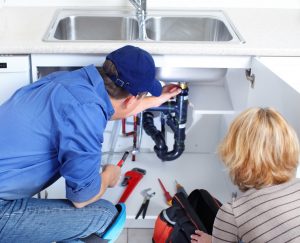Effortless Ways to Repair a Leaky Waste Disposal Unit
Effortless Ways to Repair a Leaky Waste Disposal Unit
Blog Article
The article in the next paragraphs on the subject of Why Is My Garbage Disposal Leaking From the Bottom? is fairly intriguing. Give it a try and make your own findings.

Waste disposal unit are important kitchen area devices that aid in taking care of food waste efficiently. Nevertheless, a dripping waste disposal unit can be a frustrating and messy problem to handle. Luckily, several leakages can be taken care of conveniently with a couple of straightforward steps. In this article, we will talk about exactly how to take care of a dripping waste disposal unit effectively.
Intro
Garbage disposals are installed under kitchen sinks and are developed to shred food waste into smaller pieces, enabling it to go through the plumbing system quickly. While these tools are generally reliable, leakages can take place with time as a result of damage, loosened links, or damage to the unit.
Common Root Causes Of Leaks in Trash Disposals
Worn Seals and Gaskets
Seals and gaskets play an essential role in avoiding water from leaking out of the waste disposal unit. With time, these elements can degrade, resulting in leakages around the disposal system.
Loose Connections
The links in between the garbage disposal and the plumbing system can come to be loosened in time, causing water to leakage out throughout procedure.
Fractures or Holes in the Disposal Unit
Physical damages to the waste disposal unit, such as cracks or openings in the real estate, can likewise result in leakages.
Determining the Source of the Leakage
Prior to trying to deal with a dripping garbage disposal, it is essential to recognize the source of the leakage. This can normally be done with visual examination or by carrying out simple examinations.
Visual Evaluation
Inspect the waste disposal unit unit meticulously for any type of indications of water leakage. Pay attention to areas around seals, gaskets, and link points.
Examining for Leaks
One means to evaluate for leakages is by running water through the disposal device and looking for any type of noticeable indications of leak.
Tools and Products Needed for Fixing a Dripping Garbage Disposal
Before starting the repair work process, collect the necessary devices and products, including a screwdriver, flexible wrench, plumbing's putty, substitute seals or gaskets, and epoxy or patching material for repairing splits or holes.
Step-by-Step Overview to Fixing a Dripping Waste Disposal Unit
Turn Off the Power
Prior to trying any repair services, ensure that the power to the garbage disposal system is shut off to stop the risk of electric shock.
Find the Leakage
Identify the precise area of the leakage and determine the cause.
Tighten up Connections
Utilize a wrench to tighten up any kind of loose connections in between the disposal device and the plumbing system.
Replace Seals or Gaskets
If the leak is because of used seals or gaskets, eliminate the old parts and change them with new ones.
Patching Fractures or Holes
For fractures or openings in the disposal device, usage epoxy or a suitable patching material to seal the broken location.
Testing the Waste Disposal Unit After Repair Work
When the repair service is full, test the garbage disposal by running water through it to guarantee that the leakage has been fixed.
Preventive Upkeep Tips to Prevent Future Leakages
To avoid future leakages, it is important to execute normal upkeep on your waste disposal unit. This consists of maintaining it tidy, preventing putting non-food products or difficult items down the disposal, and regularly checking for leaks or other issues.
Conclusion
To conclude, taking care of a dripping garbage disposal is a fairly simple process that can be completed with basic devices and products. By complying with the steps laid out in this write-up and exercising precautionary maintenance, you can keep your waste disposal unit in good working problem and prevent expensive repair work in the future.
HERE’S HOW TO FIX YOUR GARBAGE DISPOSAL
WHAT TO DO IF SOMETHING IS STUCK IN YOUR GARBAGE DISPOSAL
If the impeller won’t turn, there’s probably something stuck in the disposal. It could be a steak bone or peach pit, although plumbers report pulling all sorts of inappropriate objects out of disposals, such as bottle caps or aluminum foil. Make sure power to the disposal is off, and look inside to see if you can see the source of the jam.
Never stick your fingers in a disposal. Pull out anything you see with tongs or pliers.
If the disposal still won’t work, it may be time to call a plumber or consider buying a new disposal. GEM Plumbing & Heating is here for all of your garbage disposal needs.
WHAT TO DO IF YOUR GARBAGE DISPOSAL DRAIN IS CLOGGED
Take everything out from underneath your sink and put a bucket or other container under your disposal to catch any water that drains out. Disconnect your disposal from the power supply. If it’s plugged into a wall outlet, unplug it. If it’s hardwired into an electrical box, go to the electrical panel and turn off the breaker for the disposal. Pour ¼ cup of baking soda into the drain, followed by ½ cup of white vinegar. Give the solution a few minutes to fizz and do its work. Look into the disposal with a flashlight to see if you can see an object that might be causing the clog. If you see it, remove it using tongs or pliers. MORE TIPS ON DEALING WITH A CLOGGED GARBAGE DISPOSAL
Never use drain cleaner in a garbage disposal. It can damage the plastic parts inside the disposal. You can also be splashed with the caustic liquid while working to clear the clog. Beware! Never stick your fingers into a garbage disposal. Trust us — not a good idea. In many instances, your dishwasher drains through your garbage disposal. This allows the disposal to grind any large food particles that may be drained out of your dishwasher. There are some jurisdictions, however, where the plumbing code prohibits such a connection. WHAT TO DO WHEN YOUR DISHWASHER DRAINS THROUGH THE DISPOSAL
Run some water in the sink so your plunger has at least a ½-inch of water to create a seal and plunge vigorously up and down several times. You may need to repeat this several times. Run hot water down the drain to clear any residue that remains.

Do you really like more info about Garbage Disposal Leaking From Bottom? Post feedback down below. We'd be interested to hear your reactions about this write-up. We hope that you come back again later on. You should take a moment to distribute this blog posting if you appreciated it. Thank you so much for your time spent reading it.
Call Today Report this page